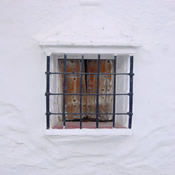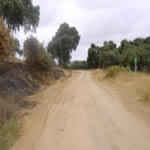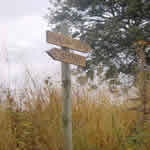Interesting Routes
Local Routes - Provincial Routes
Local Routes
Route of the Traveler Setenil de las Bodegas



Since the 16th century until the 20’s of this century, the means of land communication were unpaved paths like this one. It will be during the 18th Century when the land communications will grow in importance in the transport of travelers and when several distinguished foreign travelers went over the Andalucía region, describing us in their travel books how were the places they went through and even their customs, people, economy…
There are famous travels like those of the French Jardine, the baron Burgoing, Madame of Aulnoy, or those of the English Towsend, Beawes, Cumberland, and the Major Dalrymple, who traveled through this path which drives from Ronda to Osuna and he described us the richness of livestock, and the lush cork and holm oaks hill settled in the term of Setenil de las Bodegas.
This old path of Osuna was one of the most important commercial means furing the 18th and 19th centuries due to its junction with the royal path which used to link Sevilla with the centre of the Spanish Kingdom. This route, along with the Royal Path from Sevilla to Ronda and the small valley of Malaga lead to Setenil de las Bodegas to be very well communicated with the main cities of Andalucía and to be a village blooming economically during this age.
Difficulty: Easy
Visiting the Popular Architecture



Inside of the Historical-Artistic ensemble of Setenil, we distinguish two building classification according to their typology: popular and monumental. Even though the term “popular” encompasses an important variety of urban, suburban, and rural buildings, in this case we are going to talk about just some considerations about the urban home according to the social classes it belongs to.
The main element of this kind of architecture is the housing, that in the case of Setenil presents some peculiarities due to the orography of the territory that in other cases they may not happen.
Firstly, what characterizes the housing of Setenil is the development at height, due to the topography that difficulties the existence of wide horizontal soils. This does not imply a higher social class of the owners because in many cases, there’s only one space in each floor. Its structure is formed by limestone load-bearing walls and forged shapes with wooden beams and a very sloping two-pitch roof.
The housing distribution is unequal in the whole village, being grouped by those of the middle class around Plaza de Andalucía.
The popular house
It is characteristic because of its few exterior hollows. In addition to the doors, there are some little hollows in the upper floors in which sometimes there are no bars or windows, but a simple door. The interior is distributed in two or three spaces which are the kitchen and the bedrooms.
This type of house has been changing in the last years, being constructed homes of a new floor with toilets and current commodities but in a much reduced space.
The middle house
It is bigger than the prior, with balconies and windows in the upper floor. The hollows in the façade are more symmetric and bigger with some ornamental element in them.
These houses include the healthy advances and current commodities with a hallway as the reception previous to the house. The floor is bigger and this allows wider spaces in addition to a bedroom in the lower floor, the living room, the kitchen-dining room, and other necessary spaces. Some of them have a little backyard.
The house with courtyard
This is the one that belongs to higher social classes, adding to the previous design an interior courtyard decorated with high-quality ceramics, and a better care of ornamentation of the façades which, on the other hand, have an important length, between 15 to 20 meters.
Generally, they present an aspect of certain age due to the conservatism of that social class, even though they have adapted to the houses with health advances and services that have been produced in the previous distribution of their homes. Some houses still preserve Emblems and heraldic elements of certain age.
The cave-home
It is the most characteristic example of the popular houses registered in the Historical and Artistic Ensemble, and with peculiar notes which marks a difference between these houses and the existing one in other townships. They are natural caves used as houses, which have been classified as half-troglodyte houses due to the physical spaces where they are, where it seems that could have been a natural shelter of prehistoric settlers. They are built with a façade that closes up the passage below the canyon’s rock, being the rock itself the roof of a large part of these constructions.
Until a few years ago, these houses were for families of humble social classes and nowadays they hold typical bars or they have become garages or warehouses.
Today, we are trying to recover some of these spaces as houses or typical stores that give them back their image of houses and to care for their aspect in front of the potential tourism, at the same time to avoid the worsening of these spaces.
Other places like the soap store or the forge have never lost their function of homes.
Difficulty: Easy
Aguilera Path
It is a route that links Setenil with Sierra Mollina and the old path of Osuna, one of the most important roads, which was used as the route of union with Ronda.
Difficulty: Easy
Limosnas Path

It is a route that crosses a dense forest of scrubs and holm oaks, connecting with the called Bandoleros and Vaqueros forests. Its hundred-year-old holm oaks, became the village famous for providing exquisite cold cuts and ham of Iberian porks, because of the sweetness of its acorns.
Difficulty: Easy
Colada de Ventas de Leches


Difficulty: Easy
Point views and Streets of Setenil



The visit to Setenil de las Bodegas is one of the most pleasant ones for the person who comes to our locality, as the artistic heritage the different generation who have inhabited the village have left. Its beauty is great and just by walking around it will lead us from one monument to another, which is itself a pleasure due to the shape of the village.
The list of these places would be too long, as this locality in its whole is of incomparable beauty and as a whole causes a great impact in the observer. However, we will list the most picturesque ones.
Cuevas del Sol and Cuevas de la Sombra Streets
Both streets, which run concurrently, each one to one side of the Guadalporcum river, have a great beauty as they are, not already embedded in the rock, but running below it.
Lizón Point View
It is located at the feet of Homenaje Tower. Its privileged situation leads to the enjoyment of the most beautiful post card that the visitor can perceive in our locality. It domains from the heights the whole township.
Herrería Street
It connects the Mina street with Plaza de Andalucía. Surely, it is among the most beautiful streets of all Spain. It allows a pleasant walk below the crag.
La Villa Point View
In the same square of the Major Church, it domains from the heights the area of the goat houses, the soap stores and part of the Guadalporcum river.
Route of the Malaga’s Trace



This route has been in our century one of the most important commercial, livestock, and transport routes of Setenil. At 4km it crosses with the old path of Osuna.
Since the ancient ages, the most important ways of land communication were the unpaved roads, the same kind the one you are on the verge of exploring it. The trace or road of Málaga has been one of the most important means of commercial, livestock and transport communication of Setenil, using part of the track for the construction of a road, as in many other places of the peninsula.
The trace of Málaga, along with the Road from Sevilla to Ronda and the Osuna Road (with which it crosses), lead to Setenil de las Bodegas being very well connected with the main cities of Andalucías and to be a population economically in bloom during the 18th and 19th centuries. Currently, it has not been preserved the whole original drawing of the road, disappearing just in its intersection with the Route of the Traveler, serving as access towards it and towards the railway station which encounters with the border of the municipal term with the province of Málaga.
Difficulty: Easy
Los Bandoleros Route



The romantic legend of these territories is linked to banditry. The paths and crossroads that leave from it or that arrive to this route, were located in the middle of the forest of holm oaks, gall oaks, cork oaks, and a leafy scrub of rockroses, gorses and thymes, transforming it into the ideal arena for the mythical bandits to commit their assaults.
Among these famous bandits of the mountains, stands out the Seven Boys of Écija or Jose Mª el Tempranillo, who walked along these lands and along Sierra de Ronda y Sierra Morena. It is well known that José Mª el Tempranillo lived in this region and stopping in Setenil de las Bodegas, Torre Alháquime and El Gastor.
This route is one of the most interesting ones because of its landscape variety, its fauna and farmhouses which are in the edges, the riverbanks of the Guadalporcún river from the spring, and the archeological site and Roman ruins of Acinipo, where the route ends, after 11 km long. Throughout the itinerary, there are diverse paths which lead you to the middle of a holm oaks forest and others that in their time were important communication paths with Ronda.
Difficulty: Easy
Provincial Routes
Los Escarpes del Río Trejo Route



Settlement of singular beauty and natural richness. It runs along 5km from Setenil to Olvera by the road CA-P-422 and along the riverbanks of Trejo. It is interesting because of the physiognomy of its rocky walls, the caves and cascades it has. Thanks to the erosive and digging process, the river has been molding and shaping into a beautiful and weird geological formation.
Difficulty: Easy
Los Molinos Route



This route runs by the path Alcalá del Calle and along the riverbank of Arroyo del Alcalá, which is a branch of the river Guadalporcum. The landscape beauty of this route is found in its varied flora and fauna, as we can find goatfishes and otters, being one of the most attractive points the cascade of Molinilla.
Throughout the fluvial course there are two cereal windmills (not used currently) and the oil press in the confluence of the brook with the river Guadalporcún, which later was a still of extractions of liquor distilled from grape remains and which is in this starting point.
From the union of both courses on, one of the most beautiful natural landscapes of the region begins: Los Escarpes of the Trejo or Guadalporcún river; being remarkable its peculiar landscape formed by elevated rocky walls, cliffs, drops and cascades like that in Molino del Batán. In addition to the evident geological valor and landscape beauty, the place stands out because of the confluence of different habitats with their correspondent flora and fauna.
Difficulty: Easy

